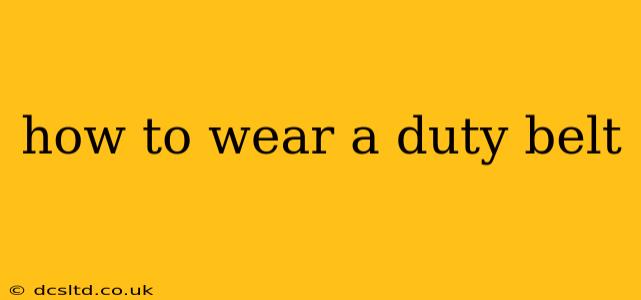Wearing a duty belt correctly is crucial for law enforcement officers, security personnel, and anyone carrying multiple tools and equipment on their person. A properly fitted and worn duty belt ensures easy access to essential items, promotes comfort during long shifts, and maintains a professional appearance. This comprehensive guide will cover everything from choosing the right belt to securing all your gear.
What is a Duty Belt?
A duty belt is a sturdy, wide belt designed to carry various tools and equipment securely. Unlike everyday belts, duty belts are significantly wider and more robust, typically ranging from 2 to 2.5 inches wide. They are constructed from durable materials like leather or heavy-duty nylon, capable of supporting the weight of multiple pouches, holsters, handcuffs, and other items. The strength and stability are vital for the safe and efficient carrying of potentially heavy gear.
Choosing the Right Duty Belt
Selecting the appropriate duty belt is the first crucial step. Several factors need consideration:
- Size and Fit: The belt should fit snugly around your waist but not be so tight as to restrict breathing or movement. Too loose, and your gear will shift and sway, compromising access and safety. Measure your waist accurately and refer to the manufacturer's size chart before purchasing.
- Material: Leather duty belts are known for their durability and classic look, but they can be heavier and require more maintenance. Nylon belts are lighter, often more affordable, and easier to clean, making them a popular alternative. Consider your climate and the amount of gear you plan to carry when selecting the material.
- Belt Style: Duty belts are available in various styles, including those with padding for increased comfort during extended wear. Consider your comfort and the demands of your job.
- Buckle Type: Strong, secure buckles are essential. Look for durable buckles made of metal or heavy-duty plastic.
How to Put on a Duty Belt: Step-by-Step Instructions
-
Fasten the Belt: Put the duty belt around your waist, ensuring the buckle is positioned in the front center.
-
Adjust the Fit: Fasten the buckle securely, making sure the belt is snug but not overly tight. You should be able to comfortably breathe and move without restriction.
-
Attach Gear: Arrange your gear strategically based on your needs and ease of access. Important items should be easily accessible and within reach.
-
Even Weight Distribution: Distribute the weight of your gear evenly across the belt to avoid discomfort and strain.
-
Regular Inspection: Regularly inspect your duty belt and equipment for wear and tear. Replace any damaged parts promptly.
What Gear Should Go on My Duty Belt?
The specific gear carried on a duty belt varies greatly depending on the profession and individual needs. Common items include:
- Holster: For your firearm.
- Handcuffs: Always easily accessible and secure.
- Magazine Pouches: For extra ammunition.
- Taser Holster (if applicable): With quick access to your Taser.
- Radio Pouch: For clear communication.
- Baton Holder: For quick and efficient deployment.
- Pepper Spray Holster (if applicable): With quick access.
- Multi-tool: For versatility and essential repairs.
- Flashlight: For low-light situations.
How to Maintain Your Duty Belt
Proper maintenance extends the lifespan of your duty belt and ensures it remains in optimal condition.
- Regular Cleaning: Regularly clean your duty belt according to the manufacturer's instructions.
- Leather Conditioning: For leather belts, apply a leather conditioner periodically to maintain its suppleness and prevent cracking.
- Inspection: Inspect the belt regularly for any signs of wear and tear. Replace any damaged parts promptly.
How Tight Should a Duty Belt Be?
Your duty belt should be snug enough to prevent your gear from shifting or sagging but not so tight that it restricts your breathing or movement. You should be able to comfortably bend, twist, and move without feeling discomfort. Think of it as a firm but not constricting fit.
What if My Duty Belt is Too Big or Too Small?
If your duty belt is too big, you can add an inner belt to take up the slack and improve the fit. If it's too small, unfortunately, it's best to replace it with a properly sized belt. Using improvised methods to alter the size is risky and could compromise safety.
This guide provides a thorough understanding of how to wear a duty belt correctly. Remember that safety and comfort are paramount; prioritize proper fit and gear placement to optimize performance and ensure your well-being. Always refer to your department’s guidelines and training for specific requirements.
